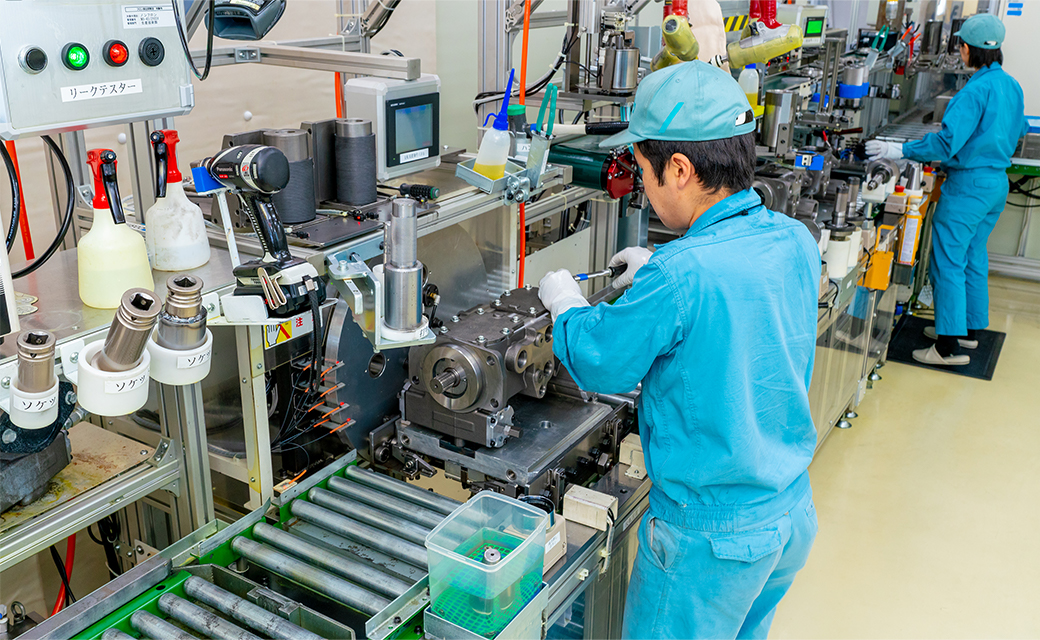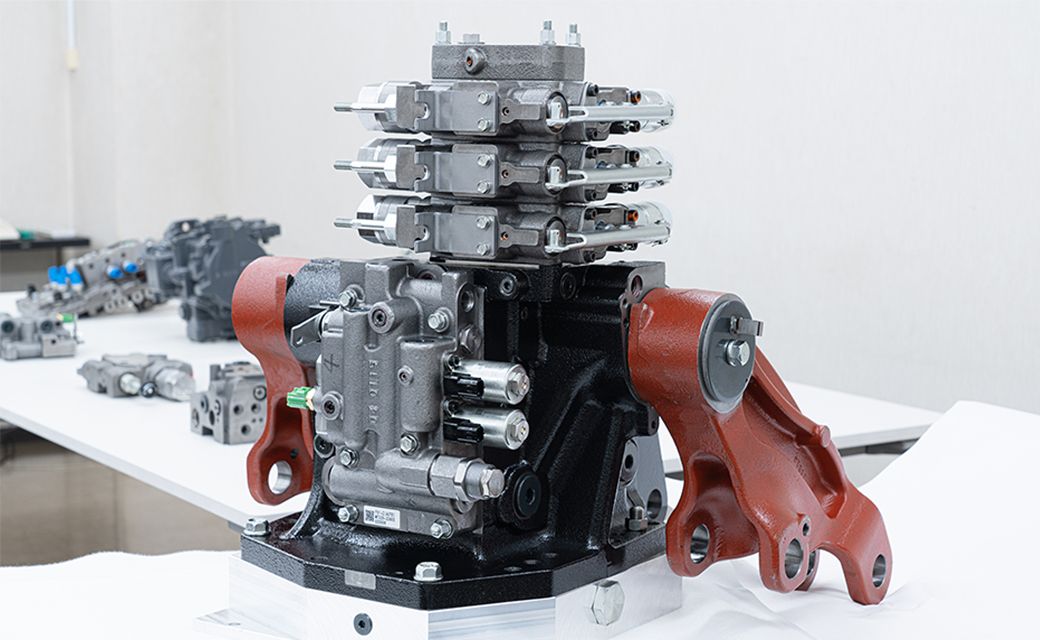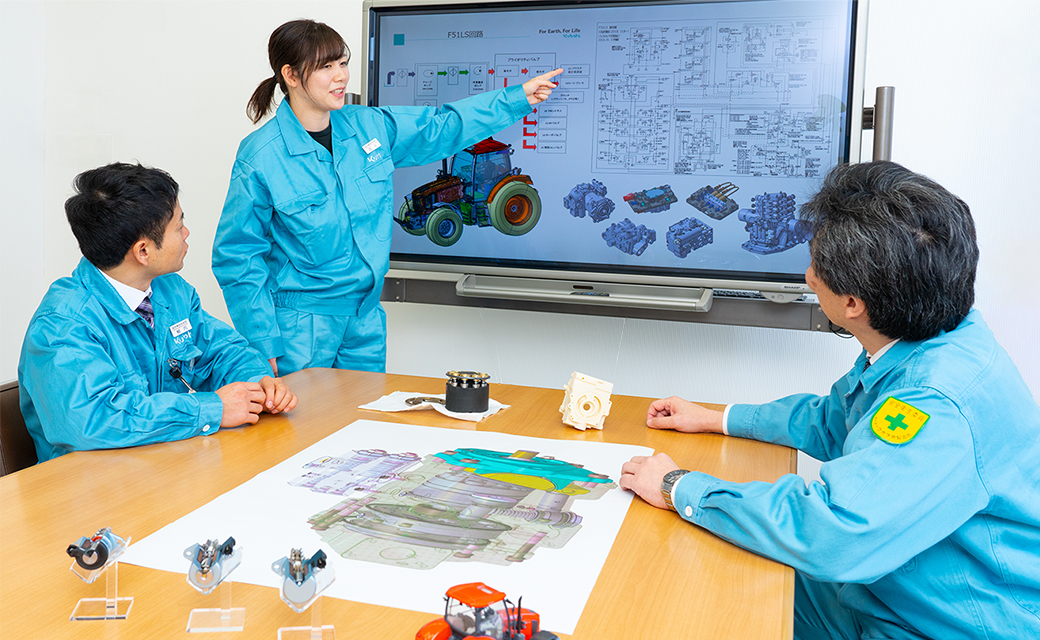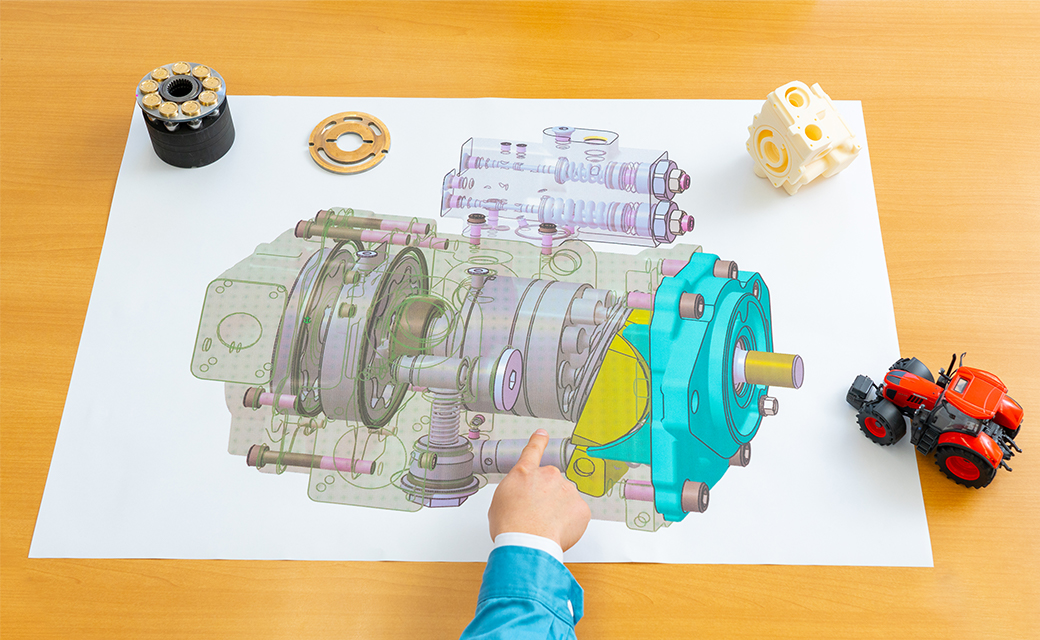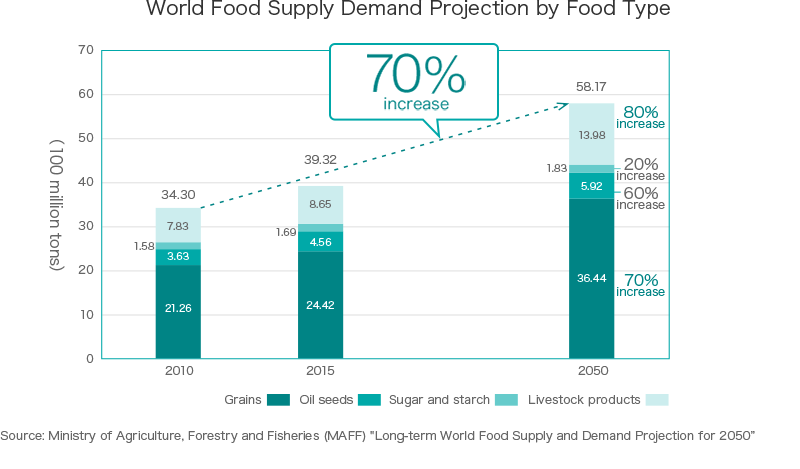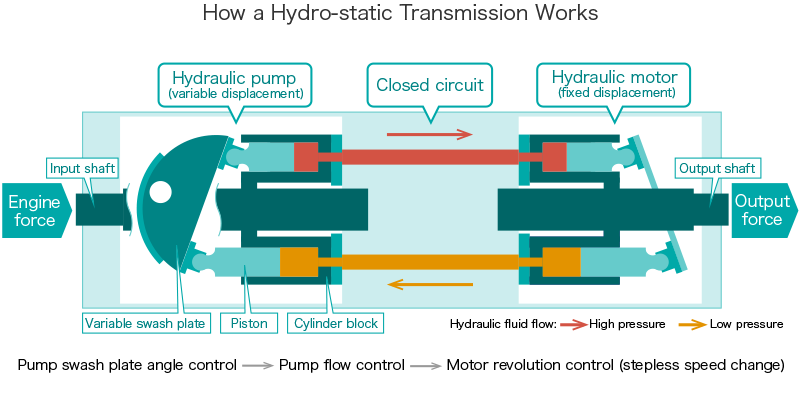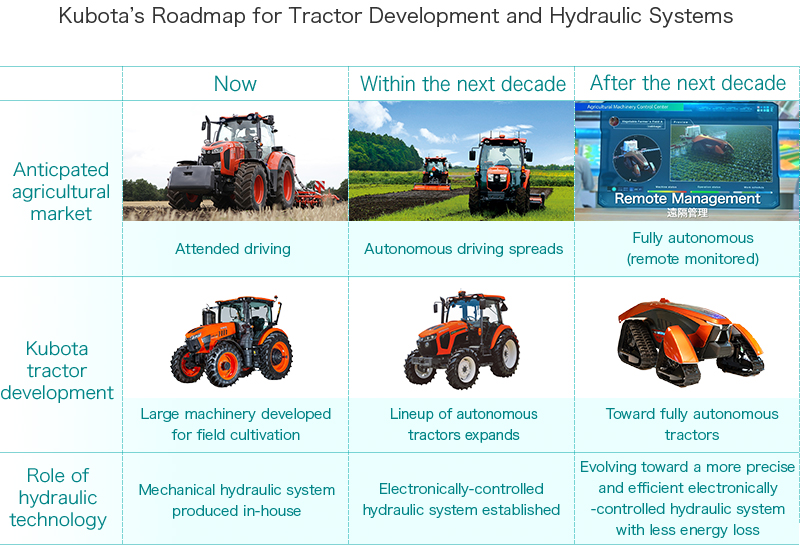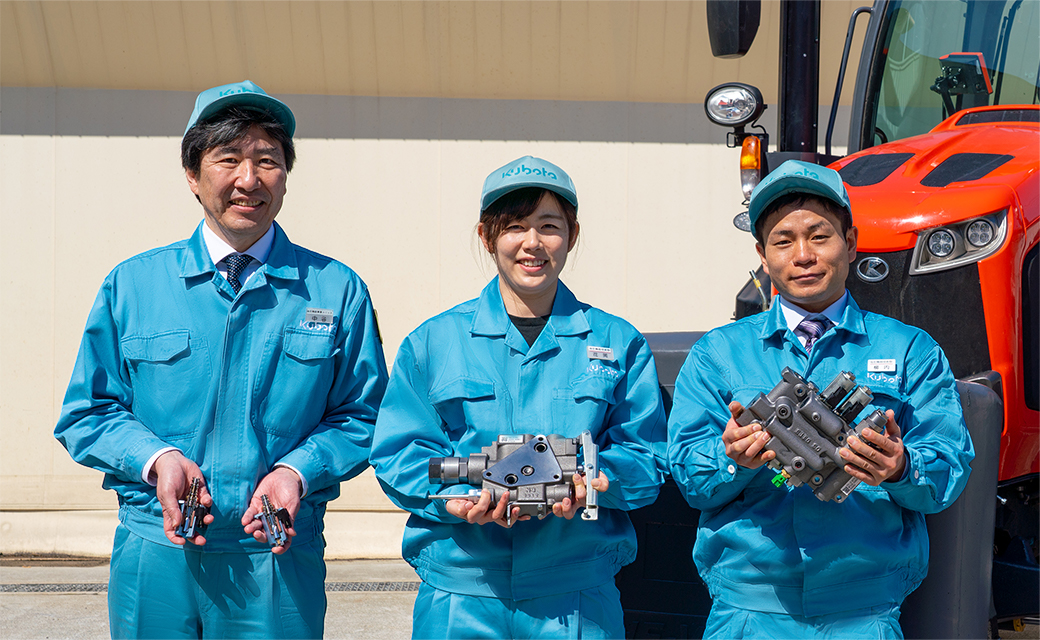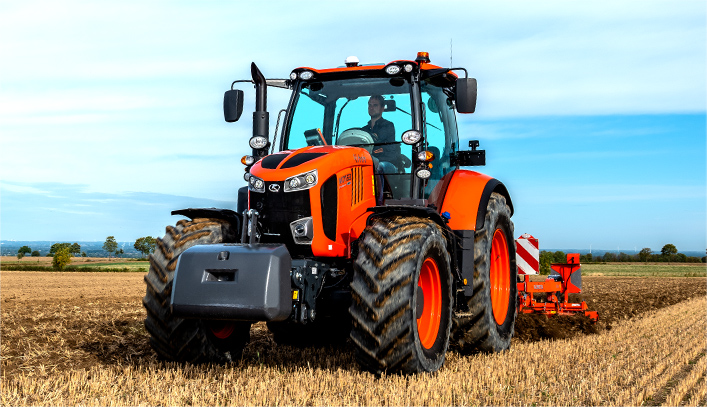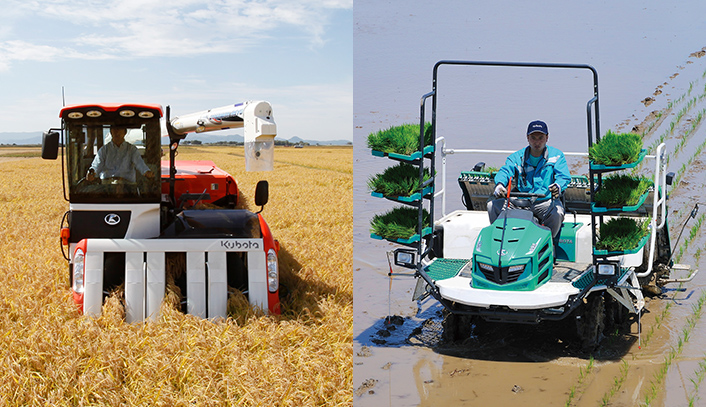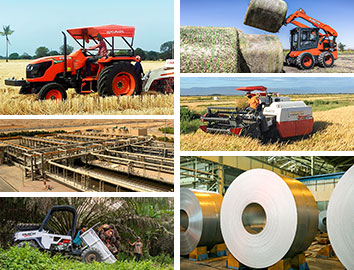In-House Production of Hydraulic Systems
and Our Challenge in Dry-Field Farming
Hydraulic Systems
Large tractors working vast fields that extend to the horizon, pulling sprayers as they do their tasks. These tractors symbolize dry-field farming throughout the world. The machines mounted on these tractors are called implements, and they come in many sizes and shapes for various kinds of work, from spraying chemicals to tilling, seeding, mowing, and pasture management. Today’s agriculture demands greater precision than ever. To ensure that implements can move as farmers need them to, including lifting, rotating, and shifting, in a waste-free and uniform manner, a hydraulic system that efficiently and reliably converts and transmits the power from the engine is required. For Kubota, taking the leap into the dry-field farming market means developing hydraulic systems.
Global demand for high-performance agricultural machinery
Agriculture today is facing urgent issues. As the population of farmers declines, demands are becoming more advanced, including needs for greater food production to meet the requirements of the rising global population and fulfillment of the UN’s Sustainable Development Goals (SDGs). Thus, the need for more precise and efficient farm work has become a pressing issue. Today there is an increasing need for advanced agricultural machinery as the key to addressing these global issues. Hydraulic systems are one of the vital core technologies that determine the performance of agricultural machinery.
Tractor hydraulic systems for precise control of wide-ranging heavy work
Hydraulic systems are composed of hydraulic devices such as pumps, valves and actuators. The mechanical force from the engine is converted into hydraulic power by the hydraulic pump and passes through one of several hydraulic valves depending on the purpose of use. At this time, the hydraulic fluid, for which pressure, flow rate, and flow direction are controlled and adjusted, is again converted to mechanical force by the hydraulic actuator and used for various operations. Compared to gears, clutches, and other mechanical devices, hydraulic systems are compact but generate a large amount of force, and also offer high degrees of controllability and flexibility in design, so they are used for work that requires greater power, such as excavation. On the other hand, because the hydraulic devices that comprise a hydraulic system move using a process that has to convert engine output into hydraulic pressure, energy loss is significant, and there are generally considered to be issues in terms of environmental burden and fuel efficiency.
Of the applications of hydraulic power in agricultural machinery, the three main types are for transport, operating, and work systems. Among these, it is mainly used for shifting gears and front and rear switching in the transport systems, and steering control in the operating systems. While these are general applications that are also used in automobiles and other transport equipment, work systems are specific to agricultural machinery, and must be allocated to the movement of the implements attached for various kinds of work such as tilling, seeding, mowing, and Pasture management. And because the various kinds of movements of implements must be controlled simultaneously, the majority of engine power is used in work systems.
Another factor required of agricultural machinery is fluid leak prevention. Fluid leaks from hydraulic pressure cannot be allowed in fields where crops are produced (fields that are partitioned to grow crops). What is more, the tremendous force required to move the implement means that the fluid is also under high pressure, so if internal leakage (leakage of fluid from small gaps between parts inside the hydraulic equipment) occurs, pressure loss will increase. Therefore, in order to maximize the conveyance of engine power, Kubota has optimized the clearance (gaps between parts) and reduced internal leakage by designing and engineering its system to units of just 0.001 mm.
-
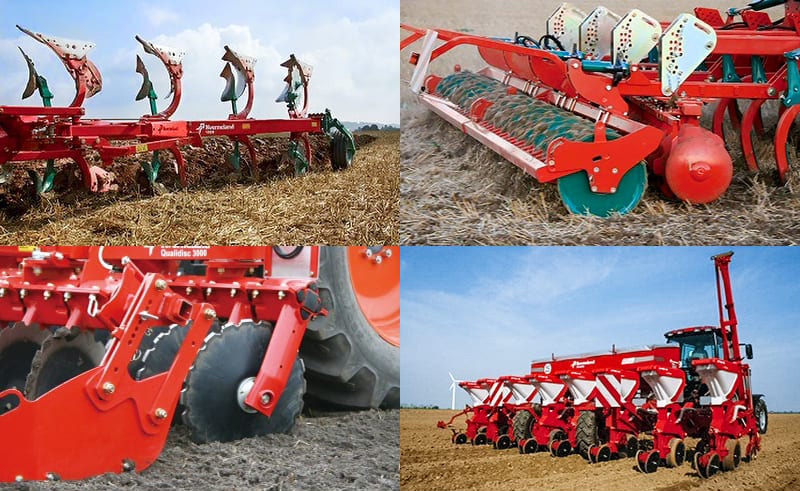
Implements perform a wide range of work, including tilling and seeding fields.
The efforts of engineers who made in-house production of hydraulic systems possible
Kubota has evolved alongside agriculture in Japan, and the company has worked to improve the performance of its rice farming machinery and refined these technologies. Leveraging its long track record and achievements, it entered the dry-field farming market to contribute to food production both domestically and worldwide. Dry-field farming covers crop acreage about four times that of rice farming, and while Kubota’s agricultural machinery, including the heavy-duty, high-horsepower tractors that it developed to address local needs, began to steadily gain acceptance throughout the global agricultural market, to achieve even greater performance meant that in-house production of a hydraulic system for dry-field farming would be inevitable.
Compared to rice farming tractors that work in paddy fields, dry-field farming tractors require greater amounts of power due to the many implements they use and the higher energy load required for working on hard soil. And in addition to the need for good responsiveness and more precise control of implements, environmental performance and fuel efficiency issues must also be solved. To meet these tall demands, the cost for developing hydraulic systems would inevitably be second only to engines, meaning that they also served as the key to cost competitiveness.
One reason behind the initiative to produce hydraulic systems in-house is that the agricultural machinery market is smaller than the automotive market, and there is little choice among suppliers looking to balance performance and cost. General-purpose products also had compatibility issues compared to exclusively-designed products, as well as limitations in terms of responsiveness and cost. What is more, Kubota was a latecomer to the North American and European dry-field farming markets, a fact that needed to be kept in mind. Implements have made technological progress particularly in the dry-field farming market, but major agricultural machinery manufacturers in North America and Europe have externally procured the hydraulic systems that can endure the diverse movements of implements. Given the established relationship between hydraulic system suppliers and major agricultural machinery manufacturers, the newcomer Kubota would not have an easy time obtaining hydraulic systems that could compete in terms of both performance and cost.
However, Kubota's hydraulic equipment development team had been accumulating technology and experience through in-house production of key components since 1976. In other words, it was the unwavering efforts of those engineers that led to the development of Kubota's unique hydraulic system.
-
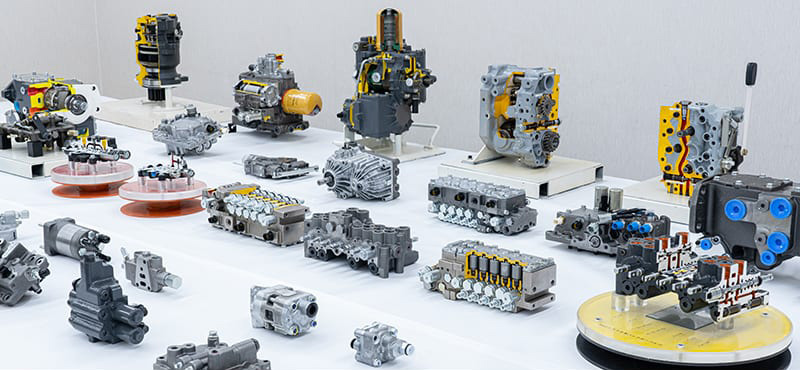
Some of the key components of Kubota’s in-house hydraulic systems.
Steadily building technologies to become the only manufacturer to make key components in-house
Kubota has been working from an early stage to bolster its systems and accumulate technologies for the key components for in-house production of hydraulic systems that make precision and high-performance agriculture possible. The company trained its workers and brought together specialists who had been scattered across various departments, and increased its number of hydraulic system development engineers by roughly five times over 20 years. By developing the necessary core technologies one-by-one, Kubota has succeeded in internally producing key hydraulic components that many major agricultural machinery manufacturers have handled through outsourcing. Today the company boasts a lineup of 100 base models and more than 700 types of hydraulic devices, developing new devices at a rate of around 20 types per year.
One of these is a hydraulic transmission called HST (Hydro-Static Transmission). Kubota’s in-house manufacturing of this system has resulted in tremendous progress in its hydraulic technologies. Unlike automobiles, agricultural machines have constant engine rotational frequencies, and the speed must be adjusted for each operation. Not only turning on and off the accelerator, but also very precise gear shifting with just the transmission and switching between forward and reverse motion must be performed with agility, and these advanced technical requirements have greatly contributed to progress in hydraulic control technology.
In addition, from the perspective of improving efficiency, the team succeeded in in-house production of a variable displacement hydraulic pump with large displacement that can freely alter the quantity of discharge, and a load sensing hydraulic system that can control the pump discharge and fluid pressure distribution valve instantly in response to changes in implement load. This makes it so that the required flow rate for each device used can be distributed with high responsiveness when necessary, and along with improvements in fuel efficiency, lower environmental impact, and more compact size, manufacturing cost has been drastically reduced compared to externally-procured units. This in-house hydraulic system is planned for installation in heavy-duty tractors for dry-field farming to be marketed in Europe, and will help accelerate Kubota’s entry into the global dry-field farming market.
-
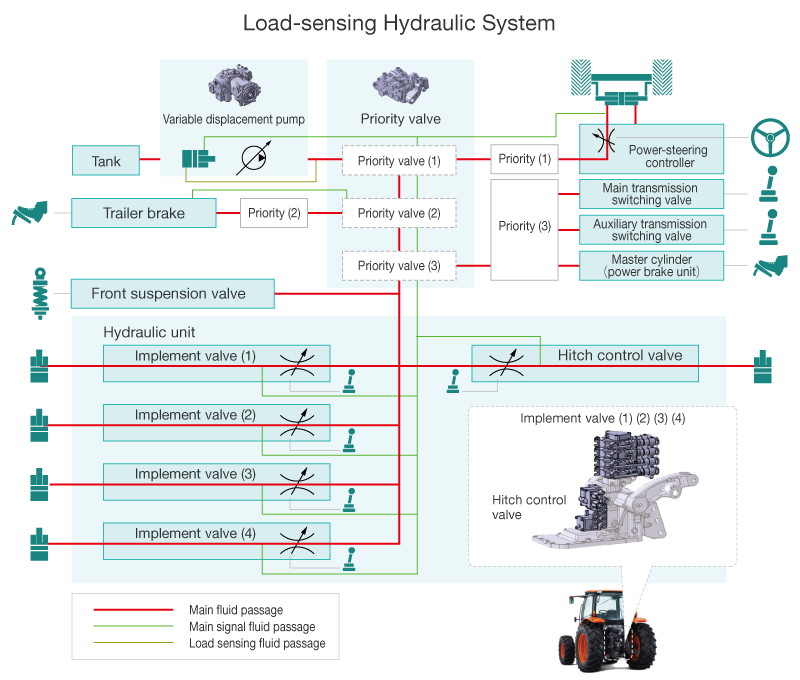
-
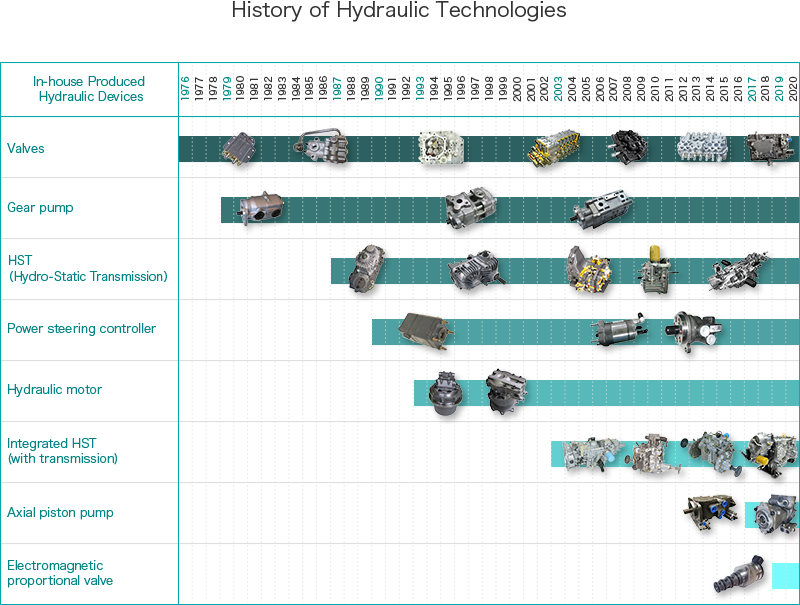
-
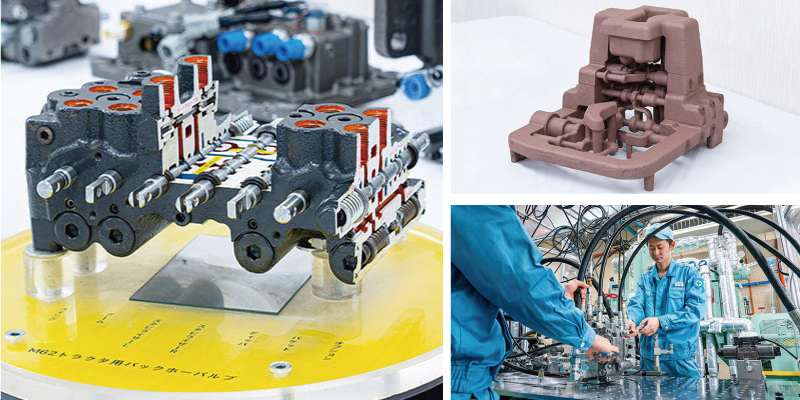
A cut model of a control valve with complex hydraulic circuits running throughout, and a core of hydraulic pumps and valves which is a sand model made for casting.
Developing a hydraulic system with fully-electronic control for automation
One of the main challenges for future hydraulic systems is to develop completely electronically-controlled hydraulic systems for the coming age of fully-automated agricultural machinery. Current, drive control performed through mechanical operations by humans using levers, pedals, dials would be operated by a by-wire (electric wire) system in autonomous tractors, and would be controlled using electrical signals. This is because electronic systems enable finer control than mechanical ones, and allow for simpler configurations in operation systems.
However, responsiveness in current electronically-controlled hydraulic systems is still inferior to that of mechanical control, so electronic control has only been realized in portions. The processors, sensors, and communication circuits that form the core technologies of autonomous tractors are rapidly increasing in speed. At the same time, hydraulic electronic control systems are advancing to a level that can offer responsiveness equivalent to mechanical control. Looking ahead to the next decade, Kubota is now at work on high-performance, compact electromagnetic valves, which are key components of electronic control. Kubota will continue to steadily accumulate technologies to help autonomous driving spread even further.
